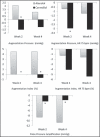Carvedilol reduces aortic wave reflection and improves left ventricular/vascular coupling: a comparison with atenolol (CENTRAL Study)
- PMID: 22142351
- PMCID: PMC8108766
- DOI: 10.1111/j.1751-7176.2011.00549.x
Carvedilol reduces aortic wave reflection and improves left ventricular/vascular coupling: a comparison with atenolol (CENTRAL Study)
Abstract
Blood pressure (BP) characteristics, such as central aortic pressure and arterial stiffness, independently predict cardiovascular events. The effects of pharmacologically dissimilar β-blockers on these properties have not been fully elucidated. Patients with essential hypertension and without significant concomitant cardiovascular disease were randomly assigned to controlled-release carvedilol, force-titrated to 80 mg (n=22), or atenolol, force-titrated to 100 mg (n=19); each was given once daily for 4 weeks. Baseline characteristics were similar. At the end of week 4, atenolol and carvedilol reduced central and brachial systolic and diastolic BP to a similar extent. Central augmentation index was increased in atenolol-treated patients but not carvedilol-treated patients (atenolol 4.47% vs carvedilol -0.68%; P=.04). Mean augmented central aortic pressure increased slightly during atenolol treatment (+1.1 mm Hg) but decreased slightly during carvedilol treatment (-1.1 mm Hg), although the difference in these changes was not statistically significant (P=.23). Pulse pressure amplification was reduced more with atenolol at week 4 (atenolol -10.7% vs carvedilol -1.8%; P=.02). Therefore, we conclude that carvedilol results in more favorable pulse pressure amplification and augmentation index by increasing arterial compliance and reducing the magnitude of wave reflection, respectively, compared with atenolol.
© 2011 Wiley Periodicals, Inc.
Figures


Similar articles
-
Different patterns of peripheral versus central blood pressure in hypertensive patients treated with β-blockers either with or without vasodilator properties or with angiotensin receptor blockers.Blood Press Monit. 2010 Oct;15(5):235-9. doi: 10.1097/MBP.0b013e32833c8a64. Blood Press Monit. 2010. PMID: 20577082
-
The vasodilatory beta-blockers.Curr Hypertens Rep. 2007 Aug;9(4):269-77. doi: 10.1007/s11906-007-0050-2. Curr Hypertens Rep. 2007. PMID: 17686376 Review.
-
Comparison of a new vasodilating beta-blocker, carvedilol, with atenolol in the treatment of mild to moderate essential hypertension.Am J Hypertens. 1994 Feb;7(2):129-36. doi: 10.1093/ajh/7.2.129. Am J Hypertens. 1994. PMID: 7910028 Clinical Trial.
-
A comparison of carvedilol with atenolol in the treatment of mild-to-moderate essential hypertension. INT-CAR-07 (U.K.) Study Group.J Cardiovasc Pharmacol. 1992;19 Suppl 1:S82-5. doi: 10.1097/00005344-199219001-00016. J Cardiovasc Pharmacol. 1992. PMID: 1378155 Clinical Trial.
-
β-blockers: a review of their pharmacological and physiological diversity in hypertension.Ann Pharmacother. 2014 Jun;48(6):723-33. doi: 10.1177/1060028013519591. Epub 2014 Mar 31. Ann Pharmacother. 2014. PMID: 24687542 Review.
Cited by
-
Heart rate and blood pressure: any possible implications for management of hypertension?Curr Hypertens Rep. 2012 Dec;14(6):478-84. doi: 10.1007/s11906-012-0306-3. Curr Hypertens Rep. 2012. PMID: 22972532 Free PMC article. Review.
-
Real time 3D echocardiography (RT3D) for assessment of ventricular and vascular function in hypertensive and heart failure patients.Cardiovasc Ultrasound. 2012 Jun 28;10:27. doi: 10.1186/1476-7120-10-27. Cardiovasc Ultrasound. 2012. PMID: 22742054 Free PMC article.
-
I Luso-Brazilian Positioning on Central Arterial Pressure.Arq Bras Cardiol. 2017 Feb;108(2):100-108. doi: 10.5935/abc.20170011. Epub 2017 Feb 13. Arq Bras Cardiol. 2017. PMID: 28327876 Free PMC article. No abstract available.
-
Central blood pressure: current evidence and clinical importance.Eur Heart J. 2014 Jul;35(26):1719-25. doi: 10.1093/eurheartj/eht565. Epub 2014 Jan 23. Eur Heart J. 2014. PMID: 24459197 Free PMC article. Review.
-
B-type natriuretic peptide trumps other prognostic markers in patients assessed for coronary disease.BMC Med. 2019 Apr 3;17(1):72. doi: 10.1186/s12916-019-1306-9. BMC Med. 2019. PMID: 30943979 Free PMC article. Clinical Trial.
References
-
- Chobanian AV, Bakris GL, Black HR,et al. The Seventh Report of the Joint National Committee on Prevention, Detection, Evaluation, and Treatment of High Blood Pressure: the JNC 7 report. JAMA. 2003;289:2560–2572. - PubMed
-
- Mancia G, De Backer G, Dominiczak A, et al. ESH‐ESC task force on the management of arterial hypertension. 2007 ESH‐ESC practice guidelines for the management of arterial hypertension: ESH‐ESC task force on the management of arterial hypertension. J Hypertens. 2007;25:1751–1762. - PubMed
-
- National Collaborating Centre for Chronic Conditions . Hypertension: Management in Adults in Primary Care: Pharmacological Update. London: Royal College of Physicians; 2006. - PubMed
-
- Williams B, Lacy PS, Thom SM, et al. Differential impact of blood pressure–lowering drugs on central aortic pressure and clinical outcomes: principal results of the conduit artery function evaluation (CAFE) study. Circulation. 2006;113:1213–1225. - PubMed
-
- Carlberg B, Samuelsson O, Lindholm LH. Atenolol in hypertension: is it a wise choice? Lancet. 2004;364:1684–1689. - PubMed
Publication types
MeSH terms
Substances
LinkOut - more resources
Full Text Sources
Medical

